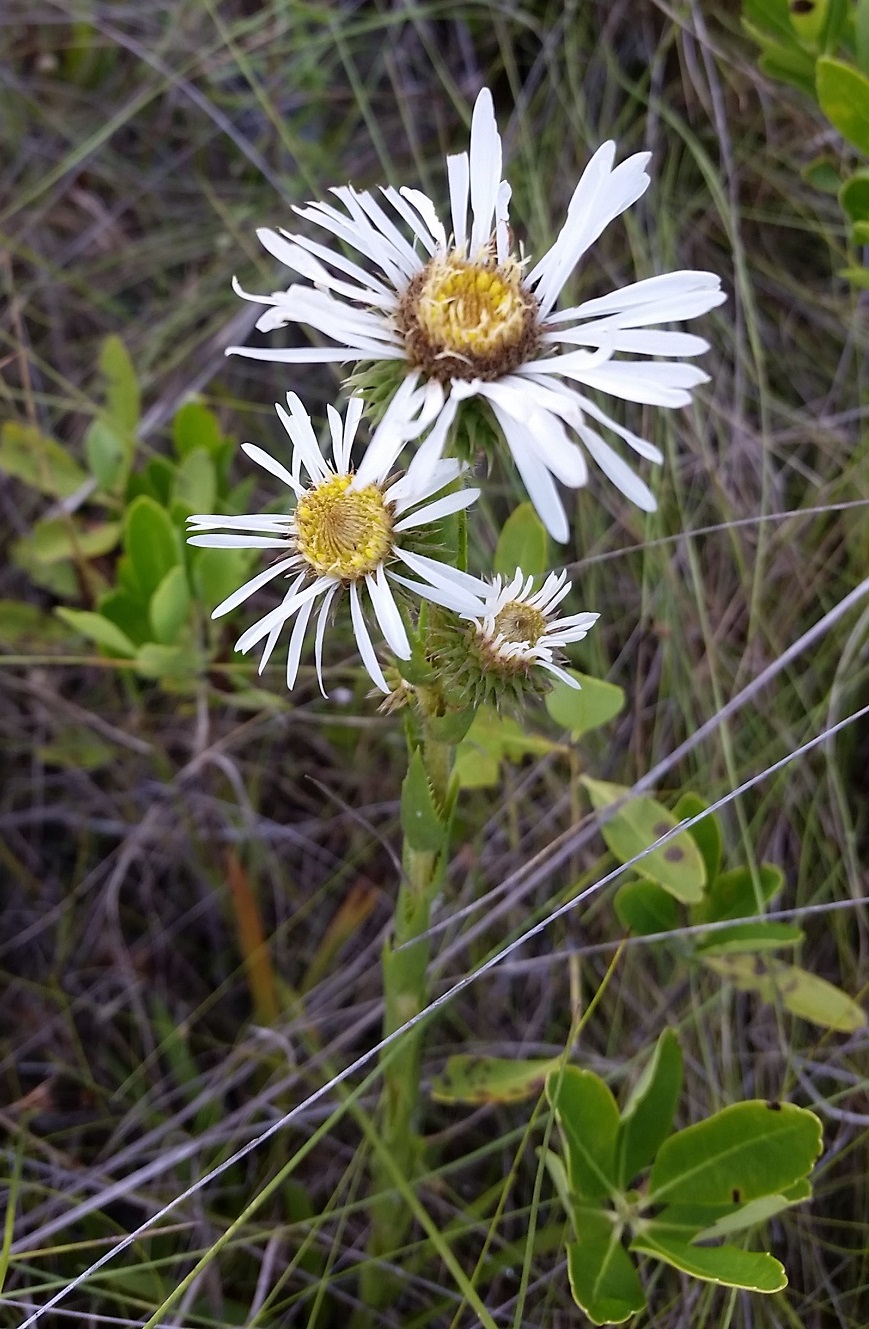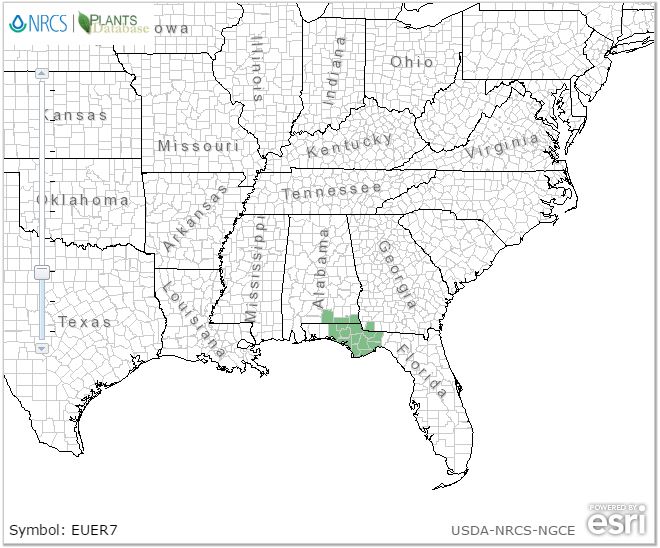Difference between revisions of "Eurybia eryngiifolia"
HaleighJoM (talk | contribs) (→Ecology) |
|||
| (7 intermediate revisions by 5 users not shown) | |||
| Line 18: | Line 18: | ||
}} | }} | ||
| − | Common | + | Common names: Thistleleaf aster; Eryngo-leaved aster |
==Taxonomic notes== | ==Taxonomic notes== | ||
| − | Synonyms: | + | Synonyms: ''Aster eryngiifolius'' Torrey & A. Gray.<ref name="weakley">Weakley, A.S. 2015. Flora of the southern and mid-atlantic states. Working Draft of 21 May 2015. University of North Carolina at Chapel Hill, Chapel Hill, North Carolina.</ref> |
| + | |||
| + | Varieties: none.<ref name="weakley">Weakley, A.S. 2015. Flora of the southern and mid-atlantic states. Working Draft of 21 May 2015. University of North Carolina at Chapel Hill, Chapel Hill, North Carolina.</ref> | ||
| + | |||
==Description== | ==Description== | ||
<!-- Basic life history facts such as annual/perrenial, monoecious/dioecious, root morphology, seed type, etc. --> | <!-- Basic life history facts such as annual/perrenial, monoecious/dioecious, root morphology, seed type, etc. --> | ||
| Line 26: | Line 29: | ||
==Distribution== | ==Distribution== | ||
| + | This species is an East Gulf Coastal Plain endemic. It's found from southwest Georgia and panhandle Florida, west to Alabama.<ref name="weakley">Weakley, A.S. 2015. Flora of the southern and mid-atlantic states. Working Draft of 21 May 2015. University of North Carolina at Chapel Hill, Chapel Hill, North Carolina.</ref> | ||
| + | |||
==Ecology== | ==Ecology== | ||
| − | ===Habitat=== <!--Natural communities, human disturbed habitats, topography, hydrology, soils, light, fire regime requirements for removal of competition, etc.--> | + | <!--===Habitat===--> <!--Natural communities, human disturbed habitats, topography, hydrology, soils, light, fire regime requirements for removal of competition, etc.--> |
| − | |||
===Phenology=== <!--Timing off flowering, fruiting, seed dispersal, and environmental triggers. Cite PanFlora website if appropriate: http://www.gilnelson.com/PanFlora/ --> | ===Phenology=== <!--Timing off flowering, fruiting, seed dispersal, and environmental triggers. Cite PanFlora website if appropriate: http://www.gilnelson.com/PanFlora/ --> | ||
| − | + | It flowers in May, June, July, Septemeber, October, and December with peak inflorescence in June.<ref>Nelson, G. [http://www.gilnelson.com/ PanFlora]: Plant data for the eastern United States with emphasis on the Southeastern Coastal Plains, Florida, and the Florida Panhandle. www.gilnelson.com/PanFlora/ Accessed: 9 DEC 2016</ref> | |
| − | ===Seed dispersal=== | + | <!--===Seed dispersal===--> |
<!--===Seed bank and germination===--> | <!--===Seed bank and germination===--> | ||
<!--===Fire ecology===--> <!--Fire tolerance, fire dependence, adaptive fire responses--> | <!--===Fire ecology===--> <!--Fire tolerance, fire dependence, adaptive fire responses--> | ||
<!--===Pollination===--> | <!--===Pollination===--> | ||
| − | <!--=== | + | <!--===Herbivory and toxicology===--> |
<!--===Diseases and parasites===--> | <!--===Diseases and parasites===--> | ||
| − | ==Conservation and | + | |
| − | == | + | ==Conservation, cultivation, and restoration== |
| + | |||
| + | ==Cultural use== | ||
==Photo Gallery== | ==Photo Gallery== | ||
<gallery widths=180px> | <gallery widths=180px> | ||
Latest revision as of 19:46, 30 June 2022
| Eurybia eryngiifolia | |
|---|---|

| |
| Photo taken by Katelin Pearson | |
| Scientific classification | |
| Kingdom: | Plantae |
| Division: | Magnoliophyta - Flowering plants |
| Class: | Magnoliopsida - Dicotyledons |
| Order: | Asterales |
| Family: | Asteracae/Compositae |
| Genus: | Eurybia |
| Species: | E. eryngiifolia |
| Binomial name | |
| Eurybia eryngiifolia (Torr. & A. Gray) G.L. Nesom | |

| |
| Natural range of Eurybia eryngiifolia from USDA NRCS Plants Database. | |
Common names: Thistleleaf aster; Eryngo-leaved aster
Contents
Taxonomic notes
Synonyms: Aster eryngiifolius Torrey & A. Gray.[1]
Varieties: none.[1]
Description
A description of Eurybia eryngiifolia is provided in The Flora of North America.
Distribution
This species is an East Gulf Coastal Plain endemic. It's found from southwest Georgia and panhandle Florida, west to Alabama.[1]
Ecology
Phenology
It flowers in May, June, July, Septemeber, October, and December with peak inflorescence in June.[2]
Conservation, cultivation, and restoration
Cultural use
Photo Gallery
References and notes
- ↑ 1.0 1.1 1.2 Weakley, A.S. 2015. Flora of the southern and mid-atlantic states. Working Draft of 21 May 2015. University of North Carolina at Chapel Hill, Chapel Hill, North Carolina.
- ↑ Nelson, G. PanFlora: Plant data for the eastern United States with emphasis on the Southeastern Coastal Plains, Florida, and the Florida Panhandle. www.gilnelson.com/PanFlora/ Accessed: 9 DEC 2016